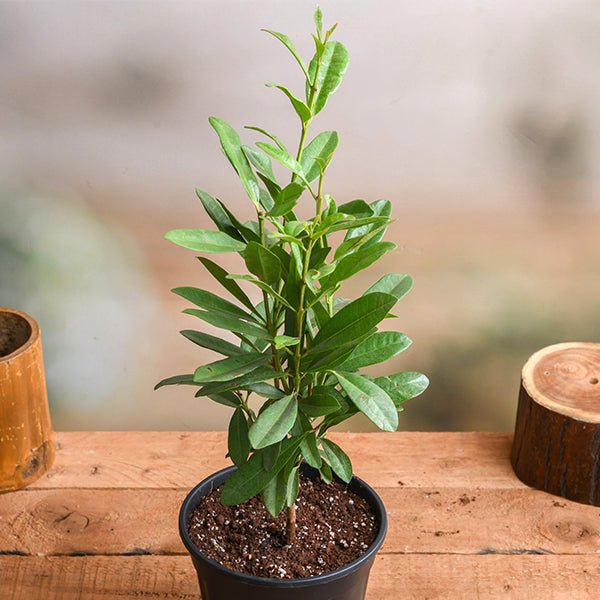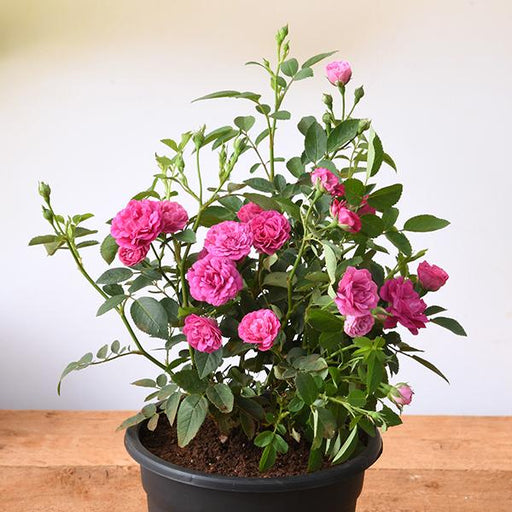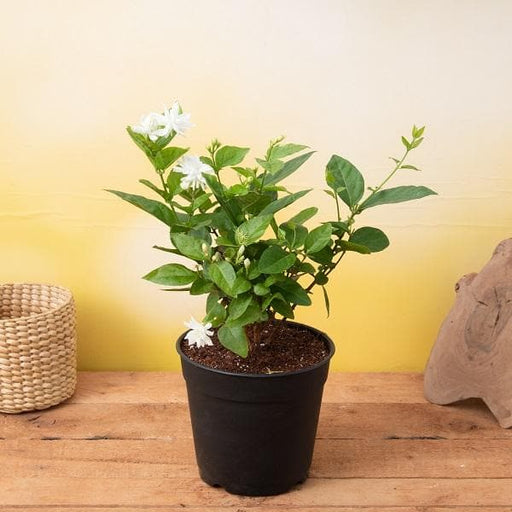
All Spice - Plant
(MRP Inclusive of all taxes)
- Shipping ₹79 for entire order
- Dispatch in 7 days
- Country of origin: India

(MRP Inclusive of all taxes)
 Save 29%
Save 29%
Air Purifier Money Plant with Pot The Air Purifier Money Plant, also known as Pothos or Epipremnum aureum, is a stunning indoor plant that...
View full details
 Save up to 15%
Save up to 15%
Peace Lily, Spathiphyllum - Plant The Peace Lily, scientifically known as Spathiphyllum, is a stunning houseplant celebrated for its elegant white...
View full details
 Save 25%
Save 25%
Jasminum sambac, Mogra, Arabian Jasmine - Plant Jasminum sambac, commonly known as Mogra or Arabian Jasmine, is a fragrant flowering plant...
View full details
 Save 18%
Save 18%
Combo Constituents Includes the Parijat Tree (Night-Flowering Jasmine), a culturally significant plant with fragrant flowers. Description The Pari...
View full details
 Save 25%
Save 25%
Miniature Rose, Button Rose (Any Color) - Plant The Miniature Rose, also known as the Button Rose, is a charming and compact flowering plant that ...
View full details Save 25%
Save 25%
Damascus Rose, Scented Rose (Any Color) - Plant The Damascus Rose, also known as Rosa damascena, is a timeless symbol of beauty and romanc...
View full details
 Save 17%
Save 17%
Beautiful Fragrant Mogra, Arabian Jasmine Plant with Pot The Beautiful Fragrant Mogra, also known as Arabian Jasmine (Jasminum sambac), is...
View full details Save 15%
Save 15%
Pack of Vermicompost and Neem Cake for House Plants Transform your indoor garden with our premium Pack of Vermicompost and Neem Cake, spec...
View full details
Pack of Plant Growth and Flower Boosters Unlock the full potential of your garden with our Pack of Plant Growth and Flower Boosters! This ...
View full details Save 38%
Save 38%
Combo of Jeevamrut and Neem Raksha for Easy Growth and Protection of Houseplants Transform your indoor garden with our exclusive combo of ...
View full details Save 22%
Save 22%
Plant Nutrients Kit (Pack of 16) for a Healthy Garden Transform your garden into a lush paradise with our Plant Nutrients Kit, featuring 1...
View full details Save 16%
Save 16%
Combo of Top Plant Fertilizers Elevate your gardening game with our exclusive Combo of Top Plant Fertilizers, featuring two bags of premiu...
View full details Save 24%
Save 24%
Pack of 4 Additives to Make Soil Healthy and Nutrient Rich Transform your garden into a thriving ecosystem with our Pack of 4 Additives de...
View full details Save 30%
Save 30%
Transform your gardening experience with our premium Combo of Perlite and Vermiculite. This unique blend is designed to enhance soil aeration and ...
View full details Save 27%
Save 27%
Combo of 2 Vermicompost and Cocopeat - Enrich Your Soil Naturally! Transform your garden into a thriving ecosystem with our Combo of 2 Ver...
View full details
 Save 35%
Save 35%
Best 6 Plants for Perfect Indoor Garden Transform your living space into a lush oasis with our curated collection of the Best 6 Plants for a...
View full details
 Save up to 50%
Save up to 50%
Mini Succulent Garden Pack Transform your space with our Mini Succulent Garden Pack, featuring a delightful collection of 4 any variety beautiful s...
View full details
 Save 30%
Save 30%
5 Best Fragrant Plants Transform your garden or indoor space into a fragrant paradise with our curated selection of the 5 Best Fragrant Plants. Th...
View full details
 Save 24%
Save 24%
Set of 2 Bonsai Looking Grafted Adeniums Transform your indoor or outdoor space with our exquisite Set of 2 Bonsai Looking Grafted Adenium...
View full details Save 45%
Save 45%
Top 4 Die Hard Succulents Pack Transform your indoor or outdoor space with our Top 4 Die Hard Succulents Pack, featuring a curated selecti...
View full details
 Save 30%
Save 30%
5 Best Indoor Plants Pack Transform your living space into a lush oasis with our '5 Best Indoor Plants Pack.' This carefully curated collection fe...
View full details
 Save 25%
Save 25%
Set of 4 Evergreen Air Purifier Plant Pack Transform your indoor space into a lush, green oasis with our Set of 4 Evergreen Air Purifier Pla...
View full details| SrNo | Item Name |
|---|---|
| 1 | All Spice - Plant |
The All Spice plant, scientifically known as Pimenta dioica, is a unique and aromatic addition to any garden. Native to the Caribbean and Central America, this evergreen shrub produces small, berry-like fruits that are harvested and dried to create the beloved allspice spice. With its warm, sweet flavor reminiscent of cinnamon, nutmeg, and cloves, the All Spice plant is a culinary treasure that enhances a variety of dishes.
What makes the All Spice plant special is its versatility. Not only does it provide a rich flavor profile for cooking, but it also boasts numerous health benefits, including anti-inflammatory and antioxidant properties. Historically, allspice was used by the indigenous peoples of the Caribbean for both culinary and medicinal purposes, making it a plant steeped in rich cultural significance.
One of the standout features of the All Spice plant is its ability to thrive in various climates, making it an excellent choice for gardeners in different regions. Its glossy green leaves and aromatic berries not only add beauty to your garden but also attract beneficial pollinators, contributing positively to the local ecosystem.
Growing the All Spice plant can have a positive environmental impact by promoting biodiversity and supporting local pollinators. Its cultivation can also help reduce the carbon footprint associated with transporting spices from distant locations, making it a sustainable choice for eco-conscious gardeners.
Who knew that planting an allspice tree could be a win-win for your garden and your taste buds? This aromatic wonder not only adds a delightful flavor to your culinary creations but also serves as a stunning ornamental tree. Imagine impressing your friends with a home-cooked meal featuring spices harvested right from your backyard. Talk about farm-to-table!
Allspice trees are like the divas of the plant world; they have specific needs to thrive. They prefer warm, tropical climates and well-drained soil. If you’re in a cooler region, you might want to consider a greenhouse or a sunroom. Just remember, they don’t like to be cold or soggy—treat them like royalty, and they’ll reward you with aromatic berries.
Allspice is the culinary equivalent of a Swiss Army knife. It can be used in sweet and savory dishes alike, making it a versatile spice for any kitchen. From jerk chicken to pumpkin pie, this spice adds a warm, complex flavor that can elevate your dishes to gourmet status. Who knew a single spice could be the life of the culinary party?
Allspice isn’t just a pretty face in the spice rack; it also boasts a range of medicinal properties. Traditionally used for digestive issues and inflammation, this spice can be your natural remedy for those pesky ailments. So, next time you’re feeling under the weather, consider brewing a warm allspice tea. Your body will thank you!
Harvesting allspice is like a treasure hunt in your garden. Wait until the berries turn a deep brown, then pluck them with care. Don’t rush; this isn’t a race! Once harvested, you can dry them out and grind them into a fine powder. Just think of the bragging rights you’ll have when you serve dishes seasoned with your very own homegrown allspice.
Allspice trees are not just about flavor; they can also help keep pests at bay. The aromatic oils in the leaves can deter unwanted insects, making your garden a less appealing place for pests. It’s like having a natural bodyguard for your plants. Who knew that a little spice could pack such a punch in the pest control department?
If you want your allspice tree to flourish, you need to pay attention to its soil requirements. Well-drained, loamy soil is the name of the game. Think of it as giving your tree a luxurious spa treatment. The right soil will ensure that your allspice tree grows strong and healthy, ready to produce those aromatic berries.
Pruning your allspice tree is like giving it a stylish haircut. Regular trimming encourages bushier growth and better air circulation. Just be sure to use clean, sharp tools to avoid any “bad hair days.” With the right pruning techniques, your tree will not only look fabulous but will also produce more berries for your culinary adventures.
Allspice trees are social creatures and thrive when planted alongside certain companion plants. Consider pairing them with herbs like basil or rosemary, which can enhance their growth and flavor. It’s like throwing a garden party where everyone gets along and contributes to the overall vibe. Who knew gardening could be so social?
While allspice trees prefer tropical climates, they can adapt to a range of conditions if given the right care. With a little extra attention, you can cultivate this spice in less-than-ideal environments. It’s like the underdog story of the plant world—against all odds, your allspice tree can thrive and bring joy to your garden.
The flavor profile of allspice is a delightful mystery that combines hints of cinnamon, nutmeg, and cloves. It’s like the spice version of a chameleon, blending in beautifully with various dishes. Whether you’re baking, grilling, or stewing, allspice adds a warm, aromatic touch that can make even the simplest meals feel gourmet.
All Spice, also known as Pimenta dioica, is a tropical evergreen plant that produces aromatic berries. These berries are dried and ground to create the beloved allspice spice. It’s like the Swiss Army knife of spices, offering flavors reminiscent of cinnamon, nutmeg, and cloves all in one delightful package!
All Spice thrives in warm, tropical climates, primarily found in the Caribbean, Central America, and parts of South America. Think of it as the diva of the plant world, demanding sunshine and humidity to strut its stuff. If you’re not in the tropics, you might need a greenhouse to keep it happy!
All Spice can be used in both sweet and savory dishes. Sprinkle it on desserts, mix it into marinades, or add it to stews for a flavor explosion. It’s like the spice equivalent of a multi-talented actor, fitting into any role with ease and leaving everyone wanting more!
Growing All Spice can be a bit of a challenge, as it prefers specific conditions. It loves warmth, humidity, and well-drained soil. If you can mimic its tropical home, you might just have a new green friend. Just remember, patience is key; good things come to those who wait!
All Spice is not just a pretty face; it boasts several health benefits! It’s rich in antioxidants, may aid digestion, and has anti-inflammatory properties. So, while you’re enjoying its delightful flavor, you’re also giving your body a little TLC. Who knew spice could be so nice
Yes, you can! The leaves of the All Spice plant are edible and can be used to infuse flavor into dishes. They’re like the understudy of the spice world, often overlooked but capable of delivering a delightful performance in soups and stews. Just don’t forget to remove them before serving!
Harvesting All Spice involves picking the berries when they’re ripe, usually when they turn a dark brown. After harvesting, they’re dried and ground to create the spice we all know and love. It’s a bit like a treasure hunt, but instead of gold, you find aromatic goodness!
All Spice has a unique flavor that combines hints of cinnamon, nutmeg, and cloves. It’s like a flavor party in your mouth, where each spice brings its own flair. This complex profile makes it a versatile ingredient, perfect for both sweet and savory dishes. Who doesn’t love a good party
Yes, you can grow All Spice indoors, but it requires a sunny spot and humidity. A grow light can help if your windows don’t get enough sun. Just think of it as creating your own little tropical paradise right in your living room. Your guests will be impressed, and so will your taste buds!
Yes, All Spice and allspice refer to the same thing! The name "allspice" comes from its unique flavor that resembles a blend of several spices. It’s like the spice world’s version of a one-hit wonder, capturing the essence of multiple flavors in one delightful package. Talk about a multitasker!
To store All Spice, keep the dried berries or ground spice in an airtight container in a cool, dark place. This will help maintain its aromatic charm. Think of it as tucking your spice away for a cozy night in, ensuring it stays fresh and ready to dazzle your dishes!